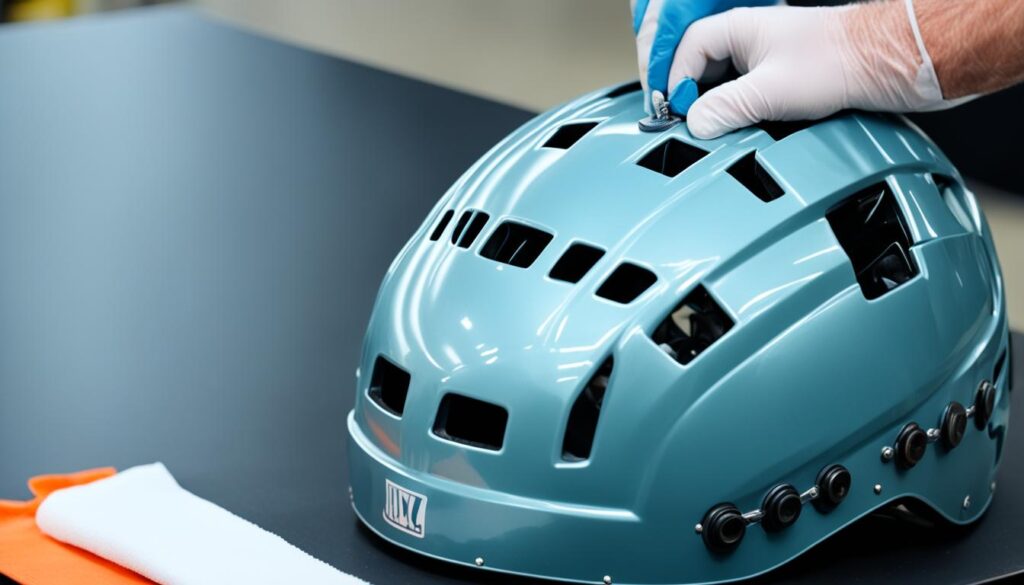
As riders, we all understand the importance of a good bucket helmet. It’s not only a crucial safety gear but also a trusted companion that protects us on every journey. Think back to the first time you strapped on your helmet and felt the reassuring weight on your head, ready to take on the open road. That moment of excitement and anticipation is one we all cherish.
But as time goes by, it’s easy to overlook the care and maintenance of our bucket helmets. We get caught up in the thrill of riding, the wind in our hair, and the freedom of the open road. We forget that our helmets need attention and care, just like any other piece of equipment.
That’s why we’re here to remind you of the importance of properly caring for and maintaining your bucket helmet. We want to ensure that your helmet remains in top condition, providing you with the best possible protection every time you embark on a ride. So, let’s dive into some essential tips and best practices for keeping your bucket helmet in prime shape.
Key Takeaways:
- Proper care and maintenance are crucial for ensuring the longevity and effectiveness of your bucket helmet.
- Regular cleaning, both externally and internally, is essential to keep your helmet in top condition.
- Invest in a proper storage solution and carry your helmet safely to prevent any damage.
- Consider replacing your helmet if it has been damaged or impacted, and upgrade to the latest technology every 5 years.
- By prioritizing helmet care and maintenance, you can preserve the quality of your bucket helmet and ride with peace of mind.
Removing External Fixtures and Cleaning Internals
Proper care and maintenance of your bucket helmet not only involve cleaning the exterior but also paying attention to the internals. To effectively clean your helmet’s internals, begin by removing any external fixtures such as the visor, GoPros, lights, and mounts. This will allow for better access to the interior and prevent any damage during the cleaning process.
When it comes to cleaning the helmet’s internals, you have the choice between hand washing and machine washing, depending on the material of the pads inside. Hand washing is recommended for helmets with removable pads. Start by preparing a gentle cleaning solution using mild soap or helmet cleanser. Take off the pads and massage them gently in the cleaning solution, paying extra attention to any areas with dirt or sweat buildup.
Once the pads have been thoroughly cleaned, rinse them under running water to remove any remaining soap or cleanser. Make sure to squeeze out the excess water from the pads without wringing or twisting them. After rinsing, leave the pads to air dry in a well-ventilated area. Avoid using a dryer or exposing them to direct heat as it may cause damage.
For helmets with non-removable pads, machine washing is the preferred option. Place the helmet in a washing bag specifically designed for delicate items. Use the gentle or hand wash setting on your washing machine, ensuring that it operates at a low speed to prevent any damage to the helmet. Once the cycle is complete, remove the helmet from the washing bag and air dry it as mentioned above.
It is important to note that when cleaning both the internals and externals of your bucket helmet, avoid using harsh chemicals or abrasive materials as they can damage the helmet’s protective features and compromise its integrity. Stick to mild soap, helmet cleanser, or specialized helmet cleaning products.
If you notice any worn-out or damaged helmet parts while cleaning, such as worn straps or loose buckles, it is crucial to replace them promptly. This ensures the optimal performance and safety of your helmet. Check with the helmet manufacturer or a trusted bike shop for replacement parts and proper installation instructions.
Proper Storage and Carrying Techniques
To maintain the quality of your bucket helmet, it is important to store it properly in a cool, dry location. Avoid storing it in extreme temperatures or direct sunlight, as this can damage the integrity of the helmet. Utilize a protective helmet bag to keep it safe from dust and debris when not in use.
During daily use or transport, consider using a helmet cover to protect the helmet’s exterior and vents from any potential damage. This will help ensure that the helmet remains in pristine condition for a longer period of time. It is crucial to prevent any scratches, dents, or cracks that could compromise the helmet’s ability to protect your head.
When carrying your helmet, it is important to be mindful of how you handle it. Avoid holding it by the chin piece, as this can put unnecessary pressure on the front vent and potentially lead to breakage. Instead, carry the helmet by the straps or grasp it securely around the base to ensure that all its components remain intact.
Investing in a proper helmet bag or storage solution is highly recommended. This will not only provide convenient storage but also offer additional protection during transport or when the helmet is not in use. A reliable helmet bag will shield your helmet from accidental bumps and knocks, keeping it in excellent condition.

Proper storage and carrying techniques play a significant role in protecting your helmet from wear and tear and preserving its longevity. By following these guidelines, you can ensure that your helmet maintains its integrity and provides optimal protection every time you ride.
Conclusion
Taking proper care of your bucket helmet is crucial for its longevity, effectiveness in protecting your head, and ensuring your safety during rides. By following the tips mentioned above, you can effectively clean and maintain your helmet’s exterior and internals, store it properly, and carry it safely.
Remember to regularly inspect your helmet for any signs of wear and tear, and promptly replace it if it has been damaged or impacted. Your bucket helmet is designed to protect you, and a compromised helmet may not provide the necessary level of protection.
Additionally, consider upgrading to the latest helmet technology every 5 years to stay up to date with advancements in safety features. The technology behind helmet designs is constantly evolving, and newer models may offer improved protection and comfort.
By prioritizing helmet care and maintenance, you are taking proactive steps to preserve the quality of your bucket helmet. Ensuring its longevity and functionality will provide you with peace of mind on every ride, knowing that you are well-equipped to face any potential dangers on the road.
Source Links
- https://www.getgeared.co.uk/blogs/beginner-guides/motorcycle-helmet-care-and-cleaning
- https://nl.foxracing.com/helmet-care-guide.html
- https://blog.doversaddlery.com/helmet-care-maintain-clean-protect-in-7-steps/

Meet James Smith, affectionately known by friends as ‘Biker Smith’, your go-to expert at ‘Best HD Helmet Camera’. At 35, living in the USA, James embodies the spirit of adventure. His life is a thrilling ride, powered by his Harley Davidson Softail and BMW S 1000 RR, with his girlfriend as his favorite travel companion. A software developer by profession, James’s heart beats for the open road, making him a full-time traveler at heart. His passion for biking and technology merges seamlessly on this platform. Recognizing a gap in discussions around helmet cameras, he founded this blog to educate and inspire fellow enthusiasts. His mission? To elevate your riding experience with the best HD helmet camera insights, backed by firsthand experiences, rigorous testing, and a genuine love for the ride. Trust James to guide you through the world of helmet cameras, where quality, innovation, and safety ride together.